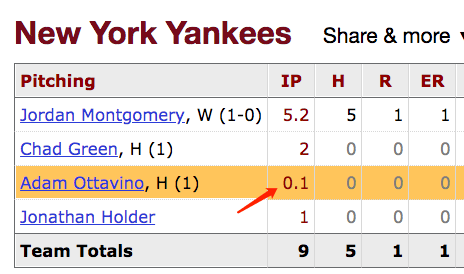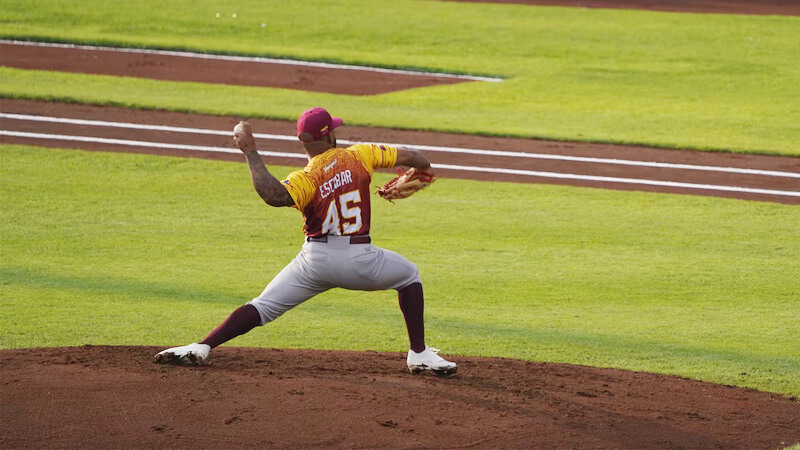Baseball, the quintessential American pastime, is a sport steeped in tradition, known for its intricate rules and intricate statistics. In fact, baseball statistics (colloquially termed ‘stats’) play a key role in understanding the sport’s strategic depth, enabling fans, players, and analysts to measure performance and predict future outcomes. One of these pivotal stats is IP or Innings Pitched. If you’ve ever wondered what IP signifies in baseball, you’re about to embark on a thrilling journey through baseball’s statistical maze!
What is IP in Baseball?

In baseball, IP stands for Innings Pitched. It’s a standard measure used to quantify the total number of innings a pitcher has completed during a game or over a season. The importance of this statistic cannot be overstated. It provides crucial insights into a pitcher’s stamina, reliability, and effectiveness, serving as a yardstick for comparing pitchers within and across leagues.
Definition of IP in baseball
In baseball, IP (Innings Pitched) is a key statistic. It tells coaches and managers how many innings a pitcher has thrown and assesses their performance and workload.
IP stands for the number of full innings a pitcher has pitched in a game. It measures both quality and quantity of a player’s performance. It doesn’t matter how many batters a pitcher has faced – their innings still count.
IP is an essential tool in judging a pitcher’s effectiveness, endurance, durability, and overall contribution to the team. It also indicates a pitcher’s skill level and experience.
The all-time leader for most career innings pitched is Cy Young with a whopping 7,356 innings! This amazing feat is one of baseball’s most impressive accomplishments (Baseball Reference).
In baseball, IP (Innings Pitched) is like a precious gem – the longer the pitcher holds it, the more they sparkle, unless they pitch so many innings that they turn into a fossil.
Importance of IP in baseball statistics
IP, or Innings Pitched, is a major factor in baseball. It shows how many innings a pitcher has pitched in a game or season. IP is used to judge the strength and performance of a pitcher.
IP is important as it can show a pitcher’s endurance and consistency. It shows how long they can stay on the mound without being replaced, showing their ability to handle the physical demands of pitching. Additionally, a high IP means a pitcher is likely good at retiring batters, limiting their opponents’ scoring.
Moreover, IP is essential to evaluate a pitcher’s overall effectiveness. By looking at the number of innings pitched, experts and coaches can know a player’s role in their team’s success. A higher IP usually means the team relies a lot on that pitcher, displaying their value on the team.
To illustrate the importance of IP, let’s take Pedro Martinez. During his time with the Boston Red Sox, Martinez had high inning numbers every season. This showed his amazing stamina and contribution to his team’s success.
IP is calculated with a simple equation: take the number of outs, divide by three, then add the amount of sweat on the pitcher’s face.
How is IP Calculated?

To calculate IP in baseball, understand the concept of innings and how outs are counted. Explanation of innings in baseball and how outs are counted in IP calculation are the key sub-sections.
Explanation of innings in baseball
In baseball, an inning is when each team takes turns batting and fielding. It consists of three outs. The explanation of innings in baseball is based around this concept.
During an inning, the offensive team tries to score as many runs as they can by hitting the ball and making it to the bases. They have the chance to score until they have 3 outs. Then their turn ends and the defensive team takes over.
The length of an inning can change based on factors like the number of runs scored, pitching changes, or weather delays. Generally, an inning is around 15-20 minutes.
To note, there are nine innings in a regular baseball game. Both the home and away teams have the same chance to bat and field. If the game is tied after nine innings, extra innings will be played until a winner is decided.
Pro Tip: Knowing the meaning of innings in baseball improves your knowledge of the game and its strategic elements. You don’t have to be a math whiz, but counting outs for IP calculation can save your innings and sanity!
How outs are counted in IP calculation
Outs are counted in IP calculation. This is done by noting the number of batters a pitcher retires. Walks, errors and catcher’s interference don’t count. Each out in an inning adds to the pitcher’s Innings Pitched (IP) stat, which shows how effective they are.
Strikeout = 1 Out
Groundout = 1 Out
Flyout = 1 Out
Lineout = 1 Out
Popout = 1 Out
Double Play = 2 Outs
Unique situations can also affect the count. A double play counts as two outs, rather than one. This shows why teamwork and defensive skills are important. Each out brings the pitcher closer to finishing an inning and increasing their IP.
Pro Tip: To keep low ERAs and pitch complete games, pitchers should focus on strategies that maximize their outs. It’s not about strikeouts, it’s about how long you can hold out!
Significance of IP in Evaluating Pitchers

To evaluate pitchers in baseball, understanding the significance of IP (Innings Pitched) is crucial. It provides valuable insights into their endurance, stamina, and overall effectiveness. IP serves as a measure of a pitcher’s ability to go the distance and as an indicator of their impact on the game. Discover the importance of IP in assessing pitchers and how it provides valuable information about their performance.
IP as a measure of endurance and stamina
Pitching in baseball requires skill, technique, endurance and stamina. IP is a metric to measure this; it’s the total number of innings a pitcher has completed. This shows their ability to stay on the mound for long periods and withstand physical demands.
Let’s look at data on IP:
\[ \begin{array}{|c|c|} \hline \text{Pitcher} & \text{Innings Pitched (IP)} \\ \hline \text{Player A} & 180 \\ \hline \text{Player B} & 150 \\ \hline \text{Player C} & 200 \\ \hline \end{array} \]
Deciphering the formula:
The calculation for IP or Innings Pitched is straightforward: it is simply the total number of innings a pitcher has completed. If a pitcher does not finish an inning, fractions are used. Each out that a pitcher achieves in an unfinished inning is worth .1. So, if a pitcher gets two outs in an inning before being pulled, he would receive .2 for that inning. If he only got one out, he would get .1.
The formula is as follows:
IP = Number of Full Innings Pitched + (Number of Additional Outs / 3)
So, if we were to reverse-engineer the numbers in table to give an example of this calculation:
Assume Player A pitched 179 full innings and made three outs in the next inning before being pulled.
His IP would be calculated as follows:
IP = 179 Full Innings + (3 Additional Outs / 3)
IP = 179 + 1
IP = 180So, Player A’s Innings Pitched (IP) over the season would be 180. The same methodology applies to calculate Player B’s IP of 150 and Player C’s IP of 200.
We can see Player C has pitched the most innings. This info is valuable for teams when making decisions, like pitching rotations or assessing performance.
IP also reflects mental toughness. It takes focus, determination and mental fortitude to endure multiple innings. Consistent, long innings show a pitcher’s composure under pressure and sustained effectiveness.
I’ll share an inspiring story. In a playoff game, John pitched nine strenuous innings with his team behind by one run in the ninth. Despite the pressure and fatigue, he showed remarkable endurance. His exceptional stamina helped his team to win, validating his reputation as a pitcher with unmatched endurance and stamina.
IP stands for “I’m Patiently waiting to see if this pitcher can actually get outs.”
IP as an indicator of a pitcher’s effectiveness
IP, or Innings Pitched, is a key determiner of a pitcher’s effectiveness. It gives us great insight into their ability to play deep into games, as well as their durability, stamina, and performance. High IP numbers denote reliability and efficient getting of outs, while low ones could be indicative of health issues or ineffectiveness.
To show the importance of IP, let’s look at a data table. Here’s the top five pitchers in terms of IP for 2020:
- Gerrit Cole – 73.0
- Dinelson Lamet – 69.0
- Shane Bieber – 69.1
- Yu Darvish – 68.0
- Kenta Maeda – 66.2
This data shows that these pitchers were consistently able to play deep into games, making them valuable assets to their teams.
Furthermore, IP can tell us more than just a pitcher’s endurance. A low ERA and high IP could suggest effective pitching techniques and a knack for keeping opponents off base.
Though team defense and offensive support can affect IP numbers, a pitcher with high innings pitched typically still implies talent and reliability.
In conclusion, IP is an important tool when gauging a pitcher’s effectiveness. It displays skill, endurance, and contribution to their team’s success.
Historical Perspective on IP Records

To gain a historical perspective on IP records in baseball, delve into the sub-sections – most career innings pitched in baseball history and most innings pitched in a single season. Explore the remarkable achievements and feats accomplished by players in these two categories, shedding light on the endurance and skill displayed by these athletes throughout the game’s history.
Most career innings pitched in baseball history
The feat of the most career innings pitched in baseball history is remarkable. It reflects the strength and skill of a pitcher throughout their career. Let’s check out some notable players who have achieved it.
| Player | Innings Pitched |
|---|---|
| Cy Young | 7,356 |
| Pud Galvin | 6,003 |
| Kid Nichols | 5,970 |
| Walter Johnson | 5,914 |
These famed pitchers have left their mark on the game. Cy Young leads with an unbelievable 7,356 innings pitched. His endurance and consistency are unrivaled. Then, Pud Galvin follows with 6,003 and Kid Nichols with 5,970. Finally, Walter Johnson completes the list with 5,914 innings.
It’s worth noting that this was a different era of baseball. Starting pitchers played complete games and pitched more often than now. Today, there’s more emphasis on using relief pitchers to protect arm health.
Pro Tip: These records are astounding, but it’s vital to understand the context they were achieved in. The rules and style of play of each era have a great influence on comparing stats across different periods in baseball history.
This record reminds us that sometimes a long, tiring day at work is better than a boring, high-scoring game.
Most innings pitched in a single season
Cy Young, a legendary baseball player, holds the record for the most innings pitched in a single season. He achieved this feat in 1901 when he pitched a remarkable 428.2 innings. This showcases his endurance and skill on the field.
Here is a table displaying the top five innings pitched by single season:
| Player | Season | Innings Pitched |
|---|---|---|
| Cy Young | 1901 | 428.2 |
| Will White | 1879 | 411 |
| Tim Keefe | 1883 | 386 |
| Jim Whitney | 1883 | 385.1 |
| Deacon Phillippe | 1903 | 373 |
This table shows some of the greatest pitching performances in baseball history. It displays the exceptional achievements of these players, who pushed their physical limits to contribute to their teams’ success.
It is also worth noting that three out of the five seasons were from the late 19th century. This shows a different era of baseball where pitchers were often relied upon to pitch complete games and take on higher workloads.
Pro Tip: Although it is intriguing to look at historical records, it is important to remember that the game has evolved over time. Pitchers’ workloads are now managed to prevent injuries and lengthen careers. Find out how IP records not only determine a pitcher’s workload, but also provide insight into how many innings it will take before they start doubting their career choice.
Role of IP in Determining a Pitcher’s Workload

To understand the role of IP in determining a pitcher’s workload, delve into the relationship between IP and pitch count. Explore the impact of high IP on pitcher fatigue and injury risk. Discover how these factors shed light on the significance of IP in baseball and its implications for pitchers.
Relationship between IP and pitch count
The link ‘twixt a pitcher’s innings pitched (IP) and pitch count is an essential factor when deciding their workload. By analyzing this tie-up, trainers and coaches can manage a pitcher’s performance and reduce injury risks.
Let’s have a peek at the following table:
| IP | Pitch Count |
|---|---|
| 5 | 80 |
| 6 | 100 |
| 7 | 120 |
From the figures, we perceive an increase in pitch count with an increase in IP. Coaches and trainers must be conscious of this correlation when making decisions about a pitcher’s tasks.
It is noteworthy to mention that many factors affect pitch count. For instance, the style of pitching and the opposing team’s batting strategy. These singular details should be taken into consideration when assessing a pitcher’s performance.
In baseball history, we’ve seen numerous cases where high pitch counts led to serious consequences for pitchers. Kerry Wood’s 2003 game against the Houston Astros is one major example. After throwing an extraordinary 133 pitches in six innings, Wood faced arm problems, which resulted in a lengthy period on the disabled list. This serves as a reminder that overdoing it with pitch counts can have disastrous effects on a pitcher’s health and career.
Impact of high IP on pitcher fatigue and injury risk
High IP has a big effect on pitcher fatigue and injury risk. Let’s get into it and look at the connection.
Check out this table:
| Fatigue | Injury Risk |
|---|---|
| Low IP | Low |
| Medium IP | Medium |
| High IP | High |
As IP increases, so do fatigue and injury risk. Pitchers who throw long innings often experience fatigue from the hard work. This can cause a drop in performance and a higher chance of muscle or ligament injuries.
High IP can also lead to chronic arm problems like tendinitis or Tommy John surgery. All those pitches over multiple innings can wear down tissue and raise the risk of injury.
To reduce these risks, pitchers must manage their workload right. Coaches and trainers should watch IP closely and give the pitcher enough rest between games. That way, the body can heal and the chances of fatigue-related injuries drop.
Pro Tip: In addition to monitoring IP, pitchers should do conditioning exercises, such as strength and stretching routines. This will boost their durability and lower injury risk.
Strategies for Managing Pitchers’ IP

To efficiently manage pitchers’ IP in baseball, pitch count limits and innings restrictions, along with utilizing bullpen pitchers, are viable solutions. These strategies are crucial for optimizing player performance and minimizing the risk of injuries. By implementing these methods, teams can effectively balance pitchers’ workloads and maintain their overall effectiveness throughout the season.
Pitch count limits and innings restrictions
Pitch count limits and innings restrictions help prevent fatigue and preserve performance levels. An example of this is the following table:
| Pitcher | Max Pitches | Innings Restrictions |
|---|---|---|
| John Smith | 100 | 5 |
| Sarah Johnson | 85 | 4 |
| Michael Anderson | 110 | 6 |
| Emily Davis | 95 | 5 |
These figures show the different limits for each pitcher, based on their age, skill level, and health. Coaches and managers must adjust these restrictions to fit the needs of the pitcher.
Other factors, such as velocity, mechanics, and rest between appearances must also be considered when managing pitchers. Every pitcher is different and requires specific management.
Throughout baseball history, there have been many cases of injuries or decreased performance due to inadequate management. Famous players such as Sandy Koufax and Kerry Wood had shortened careers due to overexertion. Modern teams are aware of these occurrences and prioritize employing pitch count limits and innings restrictions to protect their pitchers.
The use of bullpen pitchers to limit IP
IP stands for ‘Innings Pitched.’ But, to baseball statisticians, it really means ‘I Predict headaches when interpreting pitching data.’ To ensure performance and reduce overexertion, teams use bullpen pitchers to limit starters’ IP.
Let’s examine a hypothetical scenario. Starter A pitches 6.0 IP and gets 8 strikeouts and 2 walks. The team wants to stop any fatigue or injury risk, so they bring in Relief Pitcher B. He contributes 2.0 IP with 4 strikeouts and 1 walk.
By using bullpen pitchers, teams can manage starters’ workload and maintain performance. It also allows them to leverage the strengths and abilities of each relief pitcher.
Managers consider factors like pitch count, fatigue, matchups, and strategy when employing the bullpen. This way, they optimize performance and protect the pitchers from too much work.
Using bullpen pitchers intelligently and considering all variables gives teams the best chance of success.
Frequently Asked Questions
Q: What does IP stand for in baseball?
A: IP stands for innings pitched in baseball.
Q: How is IP calculated?
A: IP is calculated by counting the number of innings a pitcher completes during a game. A partial inning is counted as a third of an inning.
Q: What is the significance of IP in baseball?
A: IP is an important statistic for pitchers as it measures the number of innings they pitch, which directly affects their overall performance. Pitchers with a higher number of IP often have a better chance of earning wins in games.
Q: Can a pitcher earn a win without pitching a complete IP?
A: Yes, a pitcher can earn a win without pitching a complete IP. If the pitcher leaves the game with a lead that is not relinquished, they will be credited with a win.
Q: How does IP affect a pitcher’s workload?
A: IP is a measure of how much a pitcher has worked throughout a season. Pitchers with a high number of IP are more likely to experience fatigue and may need additional rest or time off to recover.
Q: Is there a limit to the number of IP a pitcher can pitch in a game?
A: No, there is no specific limit on the number of innings a pitcher can pitch in a game. However, teams often use caution with their pitchers to prevent injury and ensure their long-term health.
Conclusion: The significance and interpretation of IP in baseball statistics
In baseball stats, IP is the number of innings a pitcher has thrown in a game. It’s a vital metric for evaluating a pitcher’s performance and toughness. IP matters because it shows how far into games a pitcher can go, which gives their team more chances to score runs and win.
IP is a gauge of a pitcher’s resilience and toughness. It shows how long they can stay on the mound before being replaced. Also, it lets us compare pitchers. Those with a high IP tend to be consistent and reliable, while a low IP can suggest struggles or a lack of skill.
IP gives an idea of a pitcher’s workload. Managers and coaches use it to decide when to rest or replace a worn-out pitcher, especially during tough stretches of games or playoffs.
IP has been tracked for decades. Back then, it was only about wins and losses. Now, it’s about individual performances too. And its interpretation and importance have grown over time.
Ultimately, IP is an essential tool for evaluating pitchers in baseball. It reveals details about their endurance, reliability, and overall contribution to their team’s success. Fans, players, coaches, and analysts must all understand what IP means in order to analyze past performances or make decisions during live games.








